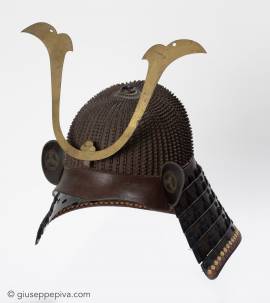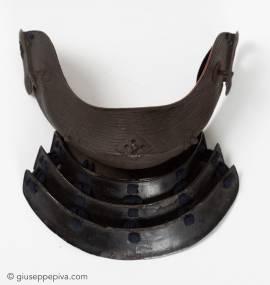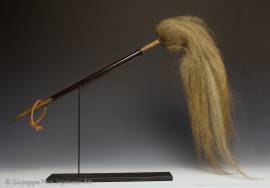Early Edo period (1615-1867)Haruta School, 17th centuryA 58-plate koboshi-bachi [helmet bowl with small standing rivets] of typical tenkokuzan form, with 30 pointed rivets on each plate decreasing in size towards the top, with the exception of the larger front plate, with three lines of rivets, for a total of 1,440 rivets.The tenkokuzan shape of this bachi, lower in the center and slightly higher on the back, is somehow more round than usual, referring the the akoda nari line from the medieval helmets.Although the helmet is unsigned, the...
WORKS FOR SALE
Early Edo Period (1615-1867)Saika or Haruta School, 17th century A samurai mask of hanbo shape, covering half face and excluding the nose.The surface is finished with parallel lines called yasurime ("file marks”) and all rivets are decorated with applied iron ornaments (kirigane) either in the shape of a chrysanthemum or of lozenges, as typical from the Saika school of armorers. The Saika school was founded in the early 17th century by a group of armor-makers of the Haruta group who moved to Kii province, in the village of Saika.The tare (throat protection) is in...
Commander baton Mid Edo Period (1615-1867)Wood with golden-copper mounts and horsehairLenght: 56 cmBorn as a tool to control the troops, the saihai changed his function during the Edo period and became an accessory to wear with the armor as a symbol of power.The saihai ‘s final can be in different materials; sometimes is applied directly to the stick, some others hung with a small rope. In this case it is decorated with hair, attached directly to the stick. The ends of the stick are decorated with golden fittings carrying two kamon (family crests)...
Copyright © 2016 - giuseppe piva - VAT: 05104180962










